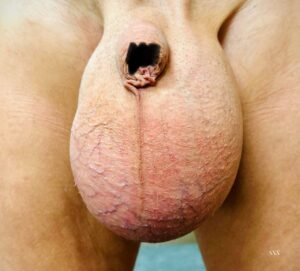A hydrocele is a buildup of fluid in the sheath surrounding the testicle, causing swelling. It is a common occurrence in newborns, where it usually disappears within a year. However, it is very much possible for adolescents and adult men, especially men over 40, to develop a hydrocele due to inflammation or injury.
A key indicator of a hydrocele is swelling in one or both of the testicles. This swelling is painless; however, the weight of the swollen scrotum may be very uncomfortable, and may be more uncomfortable the heavier it is. The hydrocele may vary slightly in size throughout the day, starting small in the morning getting larger later in the day. Hydrocele does not affect fertility, but may make sex more difficult.



Hydroceles in adults have multiple potential causes. One potential cause is fluid leaking into the scrotum through a tunnel of muscles known as the inguinal canal, through which the testicles drop into the scrotum before birth. If the canal is reopened, fluid may leak into the scrotum from the abdomen and cause a hydrocele. Inflammation of the cells lining the sac that surround the testicles can also cause hydrocele, as well as a blockage in the spermatic cord, inguinal hernia surgery, and infections.
Small Hydroceles typically do not require medical intervention. If there is pain, especially following an injury, or if it is big enough that it is affecting your quality of life, then seek medical attention immediately.
Cases where the hydrocele is too large, too uncomfortable, or is the result of an infection, may require a simple hydrocele surgery.
For adult non-communicating hydroceles, the procedure with scrotal approach involves draining out the fluid and excision or eversion of the tunica vaginalis (hydrocele sac). It can be done under local anesthesia in the most patients, and patients can return home the same day.
Dr. She has performed more than 100 cases of adult hydrocelectomy in the past 4 years, and he is one of the very few surgeons in the US who have extensive experience in performing total hydrocelectomy for the haitian patients with filarial hydrocele.




